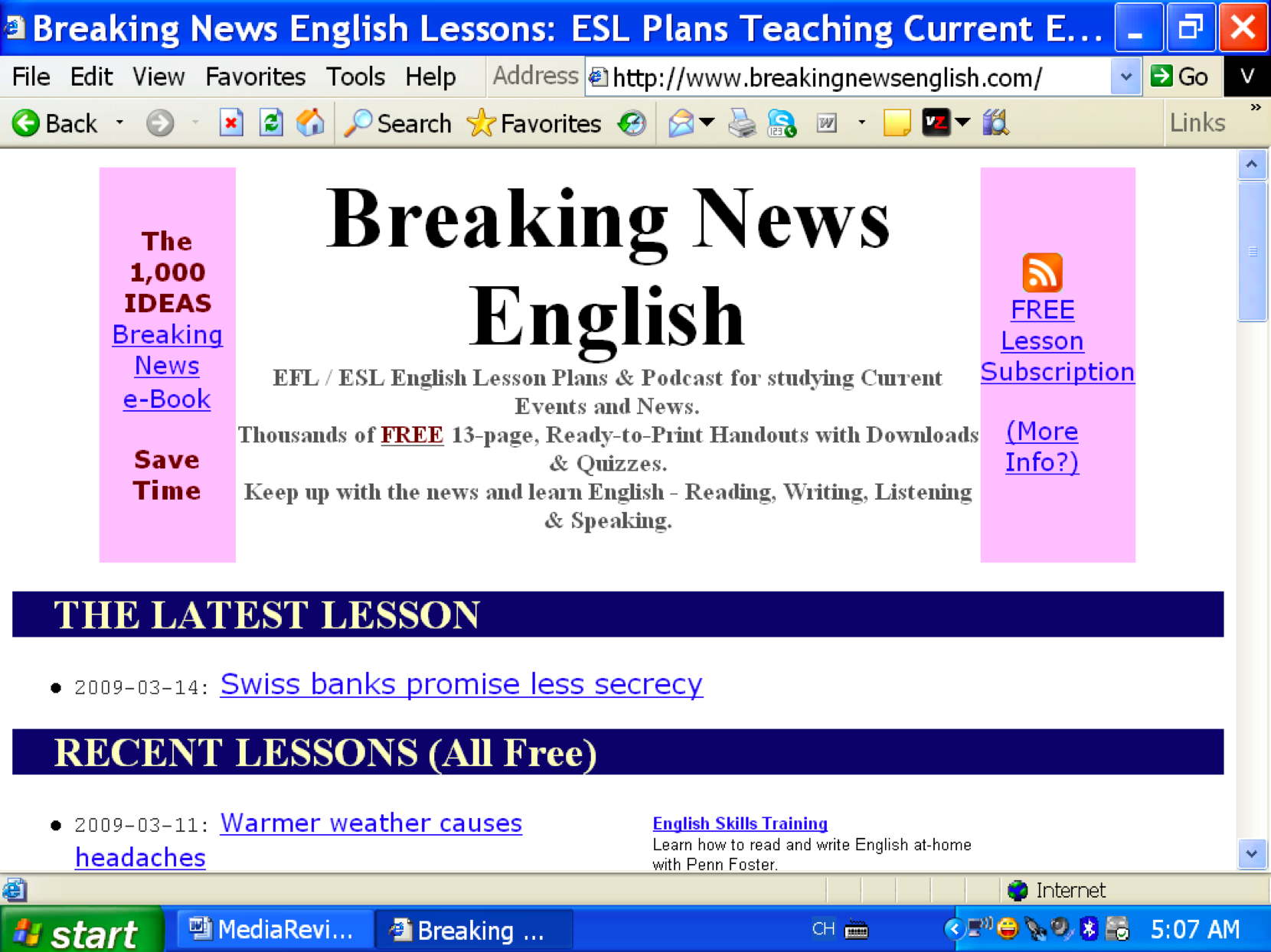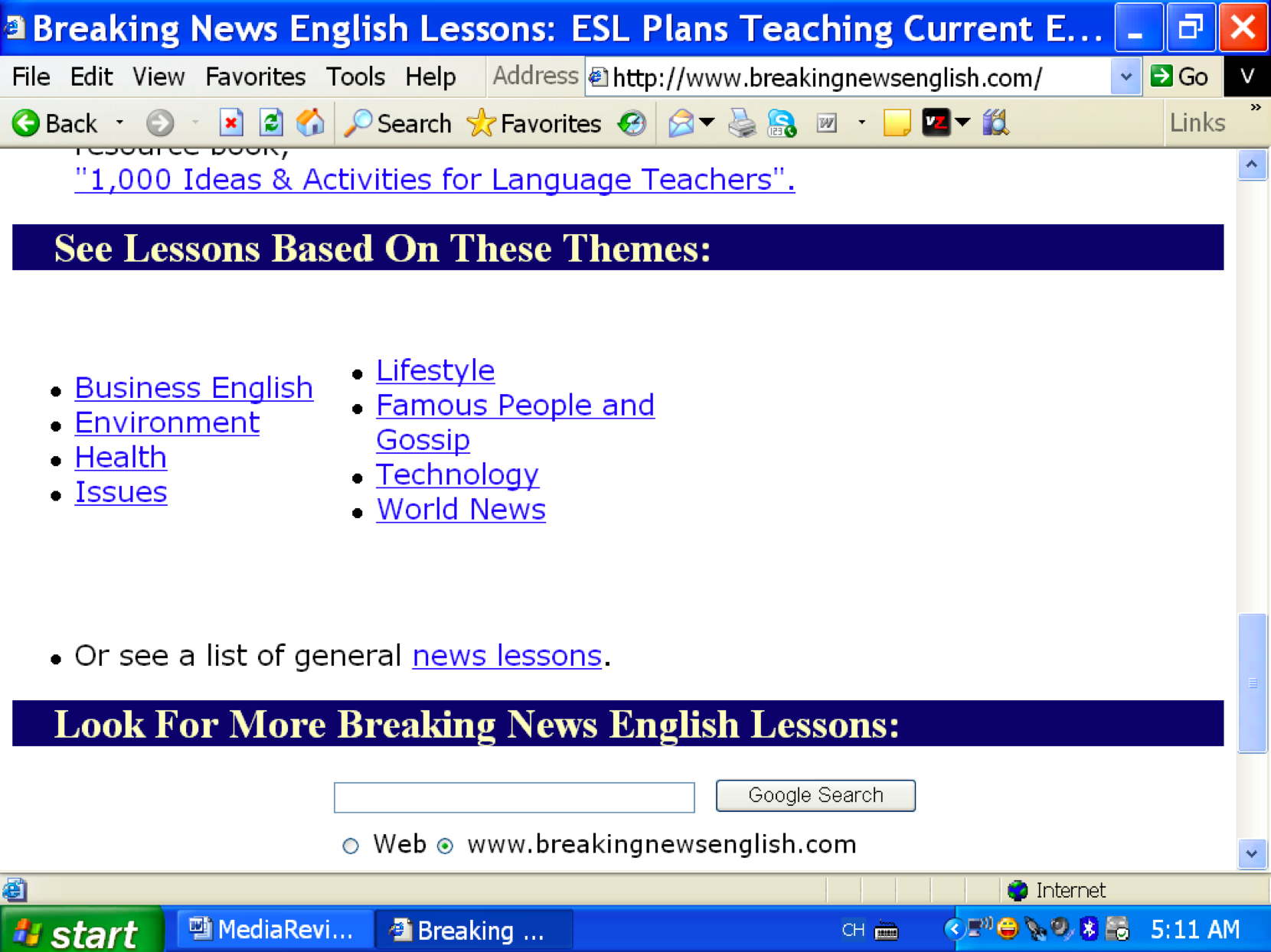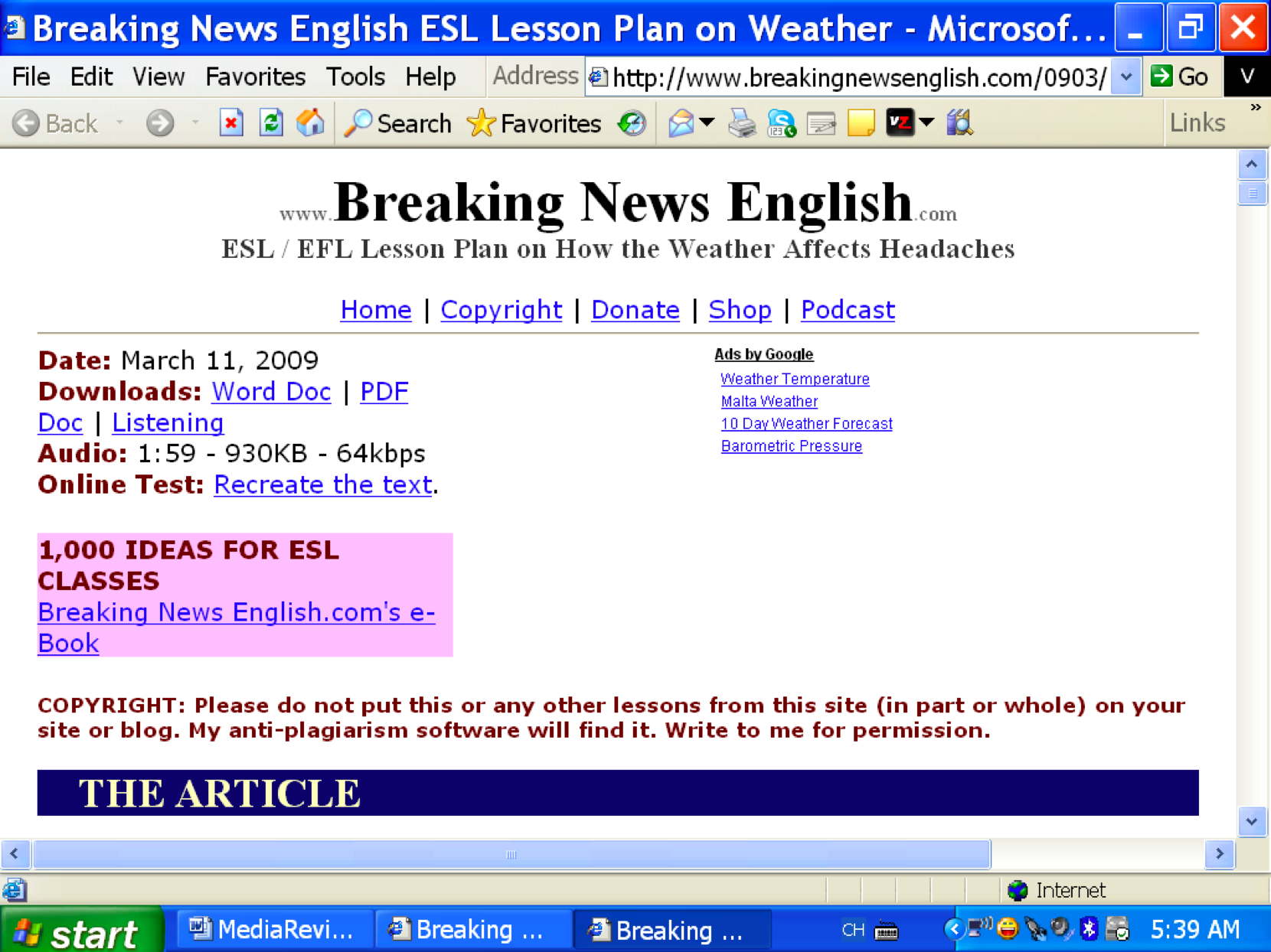
June 2009
Volume 13, Number 1
| Contents | | | TESL-EJ Top |
 |
June 2009
|
||
|
| Title | Breaking News English
(URL: http://www.breakingnewsenglish.com) |
| Author | Sean Banville |
| Type of product | Website to develop vocabulary and reading and to practice listening and writing in English |
| Minimum hardware requirements | A personal computer with Internet connection and a speakers or headphones |
| Target language | English |
| Target users | Teachers and learners of English as a second or foreign language at the intermediate level or higher |
Cummins, Brown, and Sayers (2007) propose six principles as design criteria for technology use. The principles conform to the underlying characteristics of "Mindset Two" depicted by Lankshear and Knobel (2006) and echo Lee's (2007) advocacy of using students' "cultural data sets" to achieve effective learning. First, according to Lankshear and Knobel's description, people of Mindset Two believe that digital technologies have changed learning fundamentally. For example, they do not regard learning as being linear, that is, simply between an instructor and the students. Moreover, digital technologies must be used to associate learning with learners' real world, to be "authentic," so that the learning is efficacious. On the other hand, people of "Mindset One" use digital technologies to modernize learning without changing its essence. A typical example of this mindset is digitizing materials and instructions and presenting them via a computer. Second, Cummins et al.'s emphasis on connecting students' prior knowledge to present learning reflects Lee's promotion of explicitly instructing students to use their "cultural data sets." Cultural data sets are the knowledge students obtained from their out-of-school life experiences. When instructors help them to connect their cultural data sets with academic learning, students learn efficiently.
Before examining Breaking News English using the standards proposed by Cummins et al. (2007), this review starts with an overview of this free website for teachers and learners of ESL/EFL. Generally speaking, Breaking News English provides lessons based on current events. The main content of each lesson consists of a piece of news that is typically 250 to 300 words long which is accompanied by exercises related to and extending the news text. The exercises encompass four language skills—reading, writing, listening, and speaking—with an emphasis on developing vocabulary. Every lesson proceeds from several warm-up activities to before-reading/listening exercises followed by while-reading/listening exercises and extensive after-reading/listening activities that focus mainly on language development, concluding with a 10-minute writing exercise. Five assignments are provided as homework, and answer keys to all the exercises that have definite answers are attached to the end for reference.
Overall, the homepage design renders it user-friendly. Colors and fonts denote different sections and functions on the plain-looking Web page. Moreover, the font sizes are all big enough for comfortable reading on a computer screen, except for those of advertisements (Figure 1.).

Figure 1. Homepage of Breaking News English (top half)
Lessons are presented with the latest one at the very top of the page followed by recent ones, which come at the interval of one lesson every three days. At the end of the homepage, links are available to search for older lessons grouped by themes (Figure 2).

Figure 2. Homepage of Breaking News English (bottom half)
Being user-friendly, each lesson is conveniently downloadable as a Microsoft Word or PDF file. It is also possible to listen to the news text directly by clicking the listening link. Podcasts of the news text are also provided, and users who need the podcast software can download it (Figure 3). Free subscription to the lesson plans is also available so that each new lesson will be sent to the subscriber's e-mail account or via RSS feed.

Figure 3: One Lesson Page of Breaking News English (the beginning part)
Inspecting Breaking News English with the six principles proposed by Cummins et al. (2007) reveals several positive strengths and some potential weaknesses.
Such opportunities are almost always provided in Breaking News English by warm-up activities that instruct students to think about several issues related to the topic. For example, when the news text is about the potential threat to health if one lives near fast food restaurants, the third warm-up activity provokes students to probe into other possible dangers of living close to a nuclear power station, a prison, a volcano, and a crocodile farm. Another warm-up is a debate evolving from the news for students to practice with taking a position and defending it with pertinent ideas and logical reasoning. A similar attempt is built into homework assignments by asking students to make, for instance, a poster presenting the nutritional value of different kinds of fast food. To accomplish all the tasks, especially the debate, learners need to collect information, analyze and organize it, and present their ideas convincingly.
The major drawback of all the activities designed for the lessons is that they appear to be the kind of "pretend" rather than "authentic" learning that Lankshear and Knobel advocate as the sort of "efficacious learning" (2006, p. 196) that digital technologies are capable of facilitating. For "authentic" learning to happen, students' present learning must be connected to the real world. For example, instead of instructing learners to pretend to write a letter to the researcher about his research on fast food, the activity could provide learners with the means to have either real postal or e-mail contact with the researcher. Another possibility with the same example would be instructing learners to embark on a local campaign that compels fast food restaurants in the neighborhood to reduce the health-threatening ingredients in the foods they offer to customers.
Obviously all the warm-up activities are designed to activate learners' background knowledge concerning the identified topics. Take, for example, the lesson titled Australians give blood for bushfire victims. The warm-up activities for this lesson instruct students to talk about fire and discuss with classmates what they would do to survive such disasters as a bushfire, earthquake, tsunami, hurricane, and volcano and rank in priority a list of items that they would save first when evacuating their burning houses. Nevertheless, the effort to build on students' prior knowledge and experiences demonstrated in Breaking News English is not comparable to the thorough and comprehensive use of students' "cultural data sets" foregrounded by Lee (2007). Even so, the incomparability is excusable, for the prerequisite to utilizing students' cultural data sets is that an instructor knows the sociocultural elements of students' background and experiences very well. Designing lesson plans for whoever has Internet access, the author of Breaking News English cannot possibly know what the possible students' cultural data sets are. Thus, the activities must be seen only as guides teachers can use to help students make the connection themselves instead of having the specific connections set up for them to use.
Collaboration is embedded in several activities and exercises of Breaking News English, but the extent of the collaboration is limited. The instructions that direct students to chat, discuss, or work with classmates to finish worksheets certainly involve self-regulated collaborative inquiry. However, to finish the exercises, students simply get ideas from each other, share opinions and information, and negotiate an agreement. They do not need to activate self-regulated collaborative inquiry, which involves discussing together as a team to decide the steps and tasks necessary for them to take cooperatively and use appropriate technology to investigate a topic.
Reading and writing are incorporated into the homework assignments, but not extensively because an authentic purpose for further reading or writing is not elaborated. For instance, one assignment instructs students to surf the Internet for information related to the topic of the news, which promotes further reading. Another asks students to write a magazine article on a certain topic, and the last assignment is always writing a letter to a person mentioned in the news text. Therefore, the writing expands the lesson. However, no instructions direct students to do the further reading and writing for a real-life purpose to, for example, convince the neighborhood to shut down all their lights for the Earth Hour on March 28 to advocate saving energy. Without such an authentic purpose, students may consider an assignment as something to get finished and be done with.
This is probably the weakest aspect of Breaking News English. On the surface, the lesson plan encompasses reading, listening, writing, and speaking because learners can read texts, talk with and listen to classmates, listen to the recorded reading of news texts, and write individual ideas, magazine articles, and letters. Nevertheless, the main result of doing all the activities and exercises is practice with the four language skills and development of English competence. Strategies are hardly developed, probably because of the length of the texts and the design of activities and exercises. For instance, every two-paragraph news text is about 250 to 300 words in length, and, consequently, does not contain the standard organization of journal writing for the learning of strategies to cope with such texts. Moreover, although the first before-reading/listening activity asks learners to predict what the content is with the help of only the text title, students respond by judging whether a given statement of the text detail is true or false, which probably will not lead them to develop the strategy of activating background knowledge with the title to aid comprehension. As for listening, students either pick the right word from the given list of words or write several words to fill the gaps created by taking away words from the news text. Few, if any, listening strategies can be fostered in this way. Finally, strategy training is not possible with the writing exercises. The first exercise has students write freely for ten minutes whatever they want to write about the given topic. This can be a useful strategy for collecting ideas for an actual piece of organized writing. However, no writing activity is associated with it. The second exercise asks students to write a magazine article, but no detailed instructions guide them to develop the strategies necessary to make their articles really acceptable for publication.
Efforts to promote affective involvement and identity investment are detectable in the lesson plans. For instance, the chat warm-up directs students to chat with classmates and pick from the provided list the items that are the most interesting or the most boring to them. Students' emotions are involved and their identities recognized in this activity. Nevertheless, the nature of all the lesson plans, which is classroom teaching and learning without connecting directly with the real world, limits the volume of affective involvement and identity investment.
Finally, though not related to Cummins et al.'s criteria, the most powerful strength of Breaking News English—its capacity to increase learners' English vocabulary—deserves praise because of the evidence manifested by Laufer's (2003) study. Laufer's study indicates that vocabulary exercises assist vocabulary acquisition, whereas reading alone does not. The before-reading/listening exercises of synonym match and phrase match draw students' attention to words and expressions in the text before actual interaction with the text, as do the while-reading/listening exercises of gap fill. The first after-reading/listening exercise asks students to look for collocates, other meanings, information, and synonyms of two given words that denote the news topic. After all these, one exercise instructs students to find the meanings of new vocabulary words in dictionaries, while another is a list of words for students to review how they are used in the text. Such density of attention to vocabulary is likely to result in acquisition.
In conclusion, Breaking News English is a quality English learning Website with a number of impressive strengths but with some room for improvement. Its strength lies in its potential to challenge and develop learners' cognition, facilitate learning by activating learners' prior knowledge and experiences, promote collaboration, engaged reading and writing, and foster learners' hearty and devoted participation. Moreover, its various vocabulary building exercises render it effective in assisting vocabulary acquisition. However, Breaking News English is not much more than a resource of digitalized teaching ideas and materials that are easily accessible to whoever uses the Internet. In other words, it does not exploit the depth and scope of participation and collaboration available in cyberspace with present technologies. Finally, activities that foster learners' strategies for efficient reading, writing, and learning are not provided. For some fresh ideas, the author might find it useful to consult the evaluation criteria that Yang and Chan (2008) finalized after their comprehensive literature review, interviews with teachers and learners, and surveys with experts in the field of Computer Assisted Language Learning (CALL).
Su-Su Hung is a doctoral student in Language and Literacy Education of the Department of Teaching and Learning at Washington State University in Pullman. Before studying at WSU, she had taught EFL in Wenzao Ursuline College of Languages in Kaohsiung, Taiwan, for more than 20 years. One of the courses she had taught for nearly ten years was reading English newspaper and journal articles. Her research interest is applying extensive reading to facilitate EFL learners' English competence. E-mail: <susuhung gmail.com>.
gmail.com>.
Cummins, J., Brown, K., & Sayers, D. (2007). Literacy, technology, and diversity: Teaching for success in changing times. Boston: Allyn & Bacon/Pearson.
Lankshear, C., & Knobel, M. (2006). New literacies: Everyday practices and classroom learning, 2nd Ed. London: Open University Press.
Laufer, B. (2003). Vocabulary acquisition in a second language: Do learners really acquire most vocabulary by reading? Some empirical evidence. Canadian Modern Language Review, 59, 567-587.
Lee, C. D. (2007). Culture, literacy, and learning: Taking bloom in the midst of the whirlwind. New York: Teacher's College Press.
Yang, Y.-T. C., & Chan, C.-Y. (2008). Comprehensive evaluation criteria for English learning websites using expert validity surveys. Computers & Education, 51, 403-422.
|
© Copyright rests with authors. Please cite TESL-EJ appropriately.
Editor's Note: The HTML version contains no page numbers. Please use the PDF version of this article for citations. |